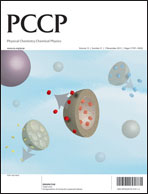B-DNA characteristics are preserved in double stranded d(A)3·d(T)3 and d(G)3·d(C)3 mini-helixes: conclusions from DFT/M06-2X study†
Abstract
We report the results of the first comprehensive DFT study on the d(A)3·d(T)3 and d(G)3·d(C)3 nucleic acid duplexes. The ability of mini-helixes to preserve the conformation of B-DNA in the gas phase and under the influence of such factors as: solvent, uncompensated charge, and counter-ions was evaluated using M06-2X functional with 6-31G(d,p) basis set. The accuracy of the models was ascertained based on their ability to reproduce key structural features of natural B-DNA. Analysis of the helicity suggests that the helical conformations adopt geometrical parameters which are close to those of the B-DNA form. The torsion angles fall somewhere between the values observed for BI/BII conformational classes. The comparative analysis of parameters of isolated Watson–Crick base pairs versus B-DNA-like conformations indicates the same tendency of base-pair polarization and hydration. Specifically, effects of polarization of nucleobases in continuum type dielectric medium mimicking water are stronger than those caused by the presence of backbone. Polar environment as well as the presence of counterions stabilizes duplexes, facilitating helix formation. Substantial conformational changes of nucleotides upon duplex formation decrease the binding energy. In spite of structural and energetic changes, the placement of a mini-helix into the gas phase does not lead to significant disruption of the structure. On the contrary, the duplex preserves its helicity and the strands remain bound.


 Please wait while we load your content...
Please wait while we load your content...